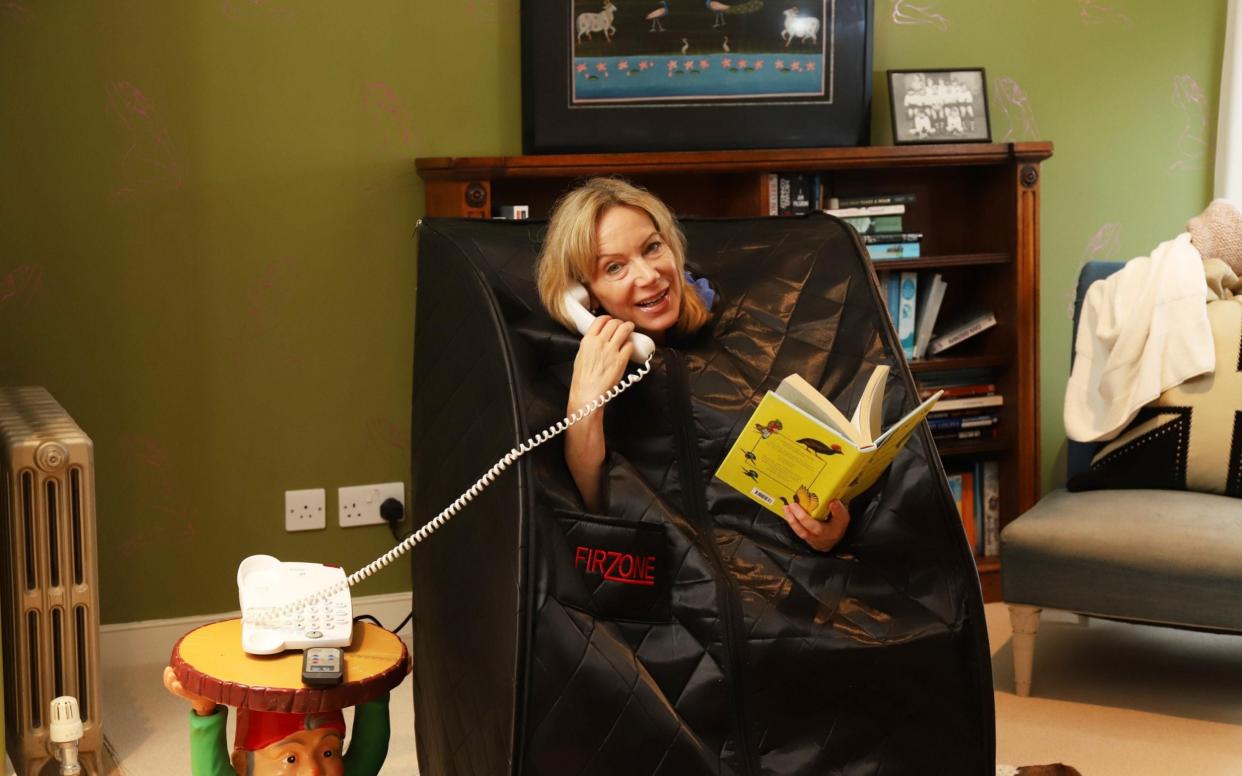Move over Peloton – home saunas are the latest lockdown fad. Here's what I think of mine

My £200 home sauna (I ordered mine from Firzone, but they’re available on Amazon) purports to do almost everything. And all I can say is, there’s something seriously wrong with you if you haven’t yet succumbed to this latest lockdown health trend.
It claims to stimulate weight loss (so you don’t have to bother), promote detox (without the headache) and cast a youthful glow (no need for expensive retinoids). You don’t even have to get particularly sweaty for your body to ease out those lockdown toxins because the infrared light (at a comfortable 65 degrees) penetrates up to seven times deeper than the heat of a traditional sauna.
Inflammation and blood pressure are also meant to come down and even your brain is said to benefit. In a study of midlife Finnish men, published in the journal Age and Ageing, it was found that those who sat in a sauna several times a week had a 65 per cent lower risk of developing dementia and Alzheimer’s disease than those who only used them once a week, which the researchers thought could be due to increased blood flow to the brain.
I bought mine on the recommendation of Dr Tamsin Lewis, a wellness expert and fellow long Covid sufferer. She swears by her all-singing and dancing carbon-panelled wooden four-person version, which is called Sunlighten MPulse and retails for between £3,000 and £10,000 (depending on the spec). She video conferences patients while sitting inside.
“The subjective evidence of wellbeing is overwhelming,” she says. “I go in mine every day. It’s a heat stress, which means it raises your heart rate and mimics the effects of exercise on the cardiovascular system. It also stimulates mitochondria, which supports the cells to produce more energy.”
Joie Risk, Sunlighten’s UK CEO, says sales have gone way beyond their projected revenue since lockdown and claims their sauna speeds up detoxification. She also mentions, however, that many of the pop-up ones similar to mine are nothing other than an electric blanket.
My version arrived in a big box with self-assembly instructions. After it had sat in the hallway for a few days, my husband took over and put it together on one condition: it should not reside anywhere in view because, in his words, “it’s hideous”. When fully assembled it looks like a quilted box cape. You unzip it, step inside and zip yourself up again. There is a timer and a heat controller as well as a little chair to sit on while your head sticks out the top.
As usual, I didn’t read any of the accompanying information (which said it works even if you aren’t spewing gallons of sweat). The heat pads on the bottom made my feet burn and the chair kept collapsing. Once I sorted that bit out (by putting a towel on the bottom and propping myself sideways) I worried that I might pass out and shrivel to death if left unattended. My husband was instructed to check on me every half hour or so (he burst out laughing whenever he entered the room).
I expected all my neighbours would be jealous and desperate to get their own (none showed the slightest interest) or that my children would come in and chat to me (they didn’t).
My body was very reluctant to abandon any of its hard-earned toxins (only my back produced a few droplets of sweat) but my face was another story. Rather than turn a healthy shade of pink, I looked like a pointillist painting. The splotches (which I worried might make my blood vessels pop, requiring another expensive visit to the dermatologist) took hours to calm down, which makes it antisocial if anything.
On the plus side, the cut-out holes for the hands means you can keep scrolling social media and drinking vodka, which I hear is what the Russians do in theirs. Although sauna safety rules say you should avoid alcohol before and after your sauna, drink several glasses of water afterwards, and to avoid them altogether when you’re feeling unwell.
Firzone’s website has some compelling writing from Dr Sarah Myhill, an ME specialist, on the levels of pesticides and chemicals in the body that come down after use (but concludes she has no data to support it).
The claim that it can be used for detox has been repudiated by Dee Anna Glaser, a dermatology professor at St Louis University and the president of the International Hyperhidrosis Society, who says that your body only releases toxins when in “rest and digest mode” rather than when in “fight or flight.” Lewis disagrees: “Sweating does flush out certain chemicals; it also produces endorphins,” she says.
I’ve had my sauna for several months now and I admit I don’t use it often because it needs warming up and because I don’t sweat much when I’m in it, so I end up more exhausted than when I started. Lewis suggests I build up gradually (15 minutes or so a day). “Eventually you will start to sweat,” she promises.
After all, like so many health trends (meditation, yoga, applying sunscreen), even home saunas demand a degree of dedication.

